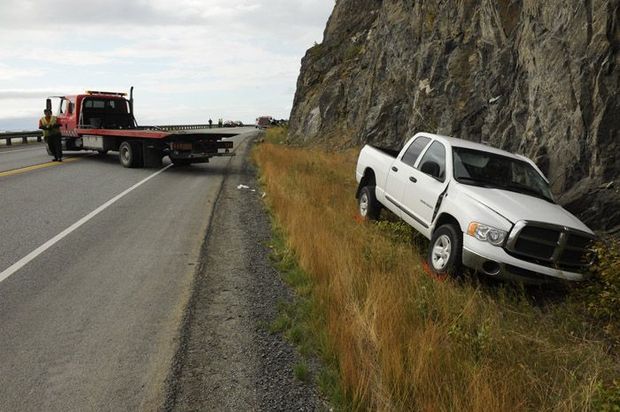
SPECIAL NOTE: REBECCA DENNISON'S BROTHER WAS INVOLVED IN THIS MULTI-VEHICLE ACCIDENT
Published: August 6th, 2009 04:01 PM
Last Modified: August 9th, 2009 01:12 AM
Along a picturesque stretch of the Seward Highway about noon Thursday, the driver of a white pickup swung into the passing lane to get around a line of cars -- a move that spurred a chain reaction of vehicle collisions that ended with two teenagers dead and a pregnant woman hospitalized, Alaska State Troopers said.
Passing lanes have been added, troopers' presence has increased and the stretch was named a safety corridor in 2006. But still the death toll rises, including a rash of deaths this summer.
That fact was a central topic at the Girdwood Community Center on Friday night, where fire chief William Chadwick called a meeting to discuss the mounting body count on the scenic byway this summer and how to stop it. There was no shortage of ideas.
"It is much better than it's ever been before, but it has not improved as quickly as our population is growing," said Kenai Peninsula Borough Mayor Dave Carey. "The reality is we have to do a better job. We, the people, have to say, 'This is unacceptable.' "
So far, eight people have died on the highway since May -- two of those deaths took place in Anchorage. The rest were killed on the winding road between Potter Marsh and Turnagain Pass.
Carey called for better and stricter enforcement, perhaps manslaughter charges for everyone who causes a fatal crash. "Whoo!" a woman called out as the crowd clapped its approval.
More than 150 people packed the standing-room only meeting. Alaska State Troopers and the Department of Transportation were on hand to hear opinions from legislators, Anchorage Assembly members and citizens, some who had come from Anchorage or the Kenai Peninsula to attend.
Participants, sometimes with clashing visions of safety, offered ideas ranging from the cheap and intuitive to the wildly expensive. They called for photo radar stations, more passing lanes, no passing lanes, more troopers, reflective lane paint, more and bigger signs, better signs for pull-outs, urging motorists to blink headlights at drivers whose are off and running safe driving ad campaigns.
HEAD-ONS
The highway sees anywhere from 5,900 vehicles a day in January to 22,000 in July. On Friday night, traffic out of Anchorage was light with little passing, almost like the entire evening rush hour decided to take it slow and enjoy the warm sun shimmering on the Inlet and highlighting green mountaintops.
But a serious showing of troopers told a different tale. At Mile 111.5, the orange spray paint where two teenagers died in a head-on collision Thursday was still fresh on the dark-stained pavement.
Diagramed on a map by the DOT, the fatal accidents since 1977 line the highway evenly like a string of pearls. About three deaths have taken place on every single mile of that 30-mile stretch, covering the road evenly, offering no hint that one part might be significantly more dangerous than another.
According to DOT crash data from 1994 to 2007, the most common type of fatal and major injury accident by far is head-on collisions, which comprise 28 percent. In a full 50 percent of fatal crashes, the causing driver had lost control of the vehicle.
Traveling at an unsafe speed contributed to fatal and major injury accidents in 30 percent of cases, with driver inattention at 10 percent. Falling asleep and improper passing represent only a fraction of cases.
"Crashes that occur while someone is passing are actually less than 10 percent of the fatal and major injury crashes on the Seward Highway corridor, but they do get a lot of attention," said Ron Martindale, highway safety improvement program coordinator with DOT. "The majority of high-severity and fatal crashes have a lot more to do with people drifting off of their lane."
Implementing the highway safety corridor -- which means double fines -- on the Seward in May 2006 reduced its fatal and major injury crashes by 77 percent the following year, according to the Alaska Highway Safety Office.
But drivers can become complacent, Chadwick said. That's why he called the meeting.
"Part of the problem is that people are starting to ignore the safety zone now," Chadwick said earlier in the week. "I don't know what we have to do to get people to listen up again."
FIXES and FINANCES
Girdwood resident Elyse Yeager proposed painting a series of V-shaped chevrons in the lanes to guide drivers forward like arrows. Such markings are cheap and have been used to successfully lower driving speeds and accident rates elsewhere, she said.
"It creates a very small optical illusion," she said. "It makes you think that the road is narrow and it makes you think that you're going fast."
Joe Banta, of Anchorage, said the solution to stopping head-on collisions is concrete median barriers, also known as Jersey barriers. Such measures are effective and comparatively cheap, he said.
"It doesn't take rocket science to really figure it out," he said. "If you can't have a head-on accident, you generally won't kill people."
DOT officials, however, say such barriers don't make sense. The barriers themselves often cause accidents for drivers piloting just a few feet away, according to Robert Campbell, director of design and construction for the DOT central region. They cut off traffic entirely so that when there is an accident, emergency vehicles and other drivers have nowhere to go. Barriers can also act as dams, puddling up water and making the road surface unsafe, he said.
"It's a system that's got some merit," Campbell said. "It would reduce the head-ons, but it would have a lot of other problems."
Perhaps the crown jewel of solutions -- a four-lane divided highway along the safety corridor -- was shot down as simply too expensive. The DOT estimates such a project would cost upward of $600 million.
Even that pricey tag, however, was not enough to ruffle its staunchest supporters.
"Those guys threw $600 million up there like it was supposed to scare us out or something," said John Gallup, a member of the Girdwood Board of Supervisors. "I see $600 million and I say, 'Hey, let's get started.' " Alaska has been dependent on federal dollars for a long time, he said. Instead the state could implement a tax and take its future into its own hands.
DOT officials agree that a four-lane divided highway would be the ideal solution but say federal funding has been declining in recent years and there just isn't the cash for it. And Rep. John Harris, R-Valdez, said if the feds won't help it won't work.
"I hear people talking about, 'Let's tax ourselves,' " Harris said. "We have 700,000 people in the state of Alaska. If you all want to be broke and you all want to buy a new road down here in Seward, then by God we could probably do it over a 30-year period. That's about how long it will take to raise that kind of money without federal help."
Instead, Harris suggested the Legislature enact mandatory penalties for crossing the center line and going the wrong way, though he didn't say what those might be.
Chadwick proposed finding more funding for troopers and starting a Seward Highway Watch, whose members would have bumper stickers warning that they report bad drivers to troopers.
A number of people said part of the answer was in finding more troopers to patrol the highway.
"Every time there's an accident on the Seward Highway you'll realize that everybody's an expert on it," Girdwood resident Matt Kissinger said. "I'm personally not an expert on it, but there's one thing that I do know, and that's that the trooper presence seems to make an impact."
RUMBLE STRIPS
Troopers recently got to the point where all their budgeted positions are filled. But 28 of the officers are still in field training, so are not yet autonomous lawmen.
"We're doing a lot with what we have and we are getting to the point where we're going to have all of our positions filled, which should make some difference," said troopers director Col. Audie Holloway. "And you should be able to see that difference on the highway."
Meanwhile, troopers have put more patrol cars on the highway -- a fact several people noted as they spoke about their drive to the meeting. There are four troopers based out of Girdwood, said Capt. Hans Brinke, commander of the Alaska Bureau of Highway Patrol. Those troopers are supplemented at times, such as on holiday weekends, by the 11 members of highway patrol based out of Soldotna, Fairbanks and Palmer.
"We've got three different regions that we're trying to take care of, and at the same time when we see more need for us to be in a particular area, we bring them all into one location and we do a higher-visibility saturation patrol," Brinke said.
Rep. Mike Hawker, R-Anchorage, said a key to the problem is a public education campaign to teach drivers better behaviors. One such project, a drowsy-driving ad campaign, is slated to begin Monday, said DOT engineer Jim Childers.
There are also a number of road improvements already under way. A $7 million rut repair project has been completed in the stretch between Indian and Potter Marsh, Childers said. The DOT is also preparing for a $2.2 million project to install center lane and shoulder rumble strips on all the safety corridors, including on the Seward from Mile 87 to 115. According to DOT, such strips, which help keep drivers in their lanes, have reduced head-on collisions by 70 percent in other states.
There are plans to install reflective markers on curves in areas where off-the-road crashes are prevalent. Markers on the Seward, Sterling, Parks and Glenn highways will cost $2 million, according to DOT. The department is also planning to reduce the curve, remove the guardrail and flatten the ditch at Mile 88 at a cost of $1.1 million.
There are other projects on the wish list that still need funding. Those include reducing the curve and adding a passing lane at Windy Corner, adding passing lanes and pedestrian ways between Ingram Creek and Girdwood and maybe adding frontage roads to reduce the number of stopping and turning vehicles between Bird and Indian.
"But safety is a statewide issue, it's not just a Girdwood issue," Campbell said. "We've got issues all over the place that we try to address, and we have a limited amount of money. That's really the issue ... how do we best utilize the limited funding we've got?"

Troopers say this Dodge pickup was headed southbound when the driver attempted to pass a line of cars and collided with northbound traffic on near mile 111.5 of the Seward Highway on Thursday, August 6, 2009. The accident involved four vehicles and resulted in two deaths.

Alex Baker, 19, and Rodney Rogers, 16, both of Soldotna, were killed when their vehicle was struck head-on by a pickup truck that was attempting to pass a line of cars near mile 111.5 of the Seward Highway on August 6, 2009.
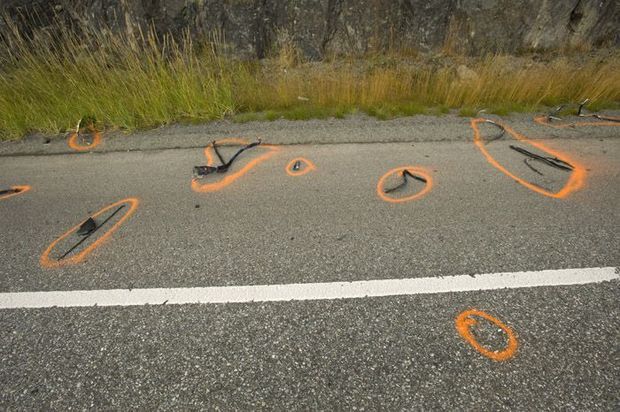
Debris is strewn along the Seward Highway. Troopers say that one southbound pickup truck trying to pass a line of vehicles collided with oncoming traffic on the Seward Highway near mile 111.5. Two people were killed in the crash that involved four vehicles on Thursday, August 6, 2009.
Traffic is backed up on the Seward Highway along Turnagain Arm after a double fatality accident closed the road at milepost 111.5 on Thursday August 6, 2009.
Traffic is backed up on the Seward Highway along Turnagain Arm after a double fatality accident closed the road at milepost 111.5 on Thursday August 6, 2009.
Workers load vehicles wrecked vehicles on the Seward Highway along Turnagain Arm after a double fatality accident closed the road at milepost 111.5 on Thursday August 6, 2009.
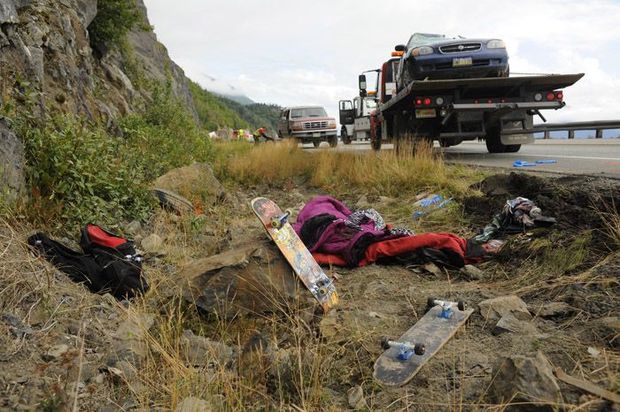
Belongings are strewn in a ditch along the Seward Highway following a crash that killed two people and involved four cars on Thursday, August 6, 2009.
Traffic is backed up on the Seward Highway along Turnagain Arm after a double fatality accident closed the road at milepost 111.5 on Thursday August 6, 2009.
Traffic is backed up on the Seward Highway along Turnagain Arm after a double fatality accident closed the road at milepost 111.5 on Thursday August 6, 2009.
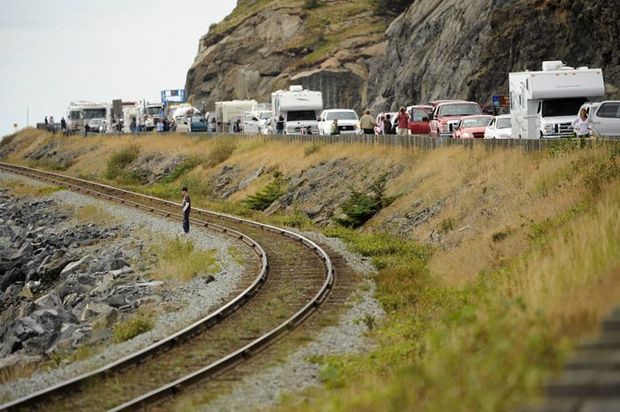
A long line of cars is stopped along the Seward Highway on Thursday afternoon, August 6, 2009. Troopers closed the highway to investigate and clear a car accident that involved five vehicles and killed two people.
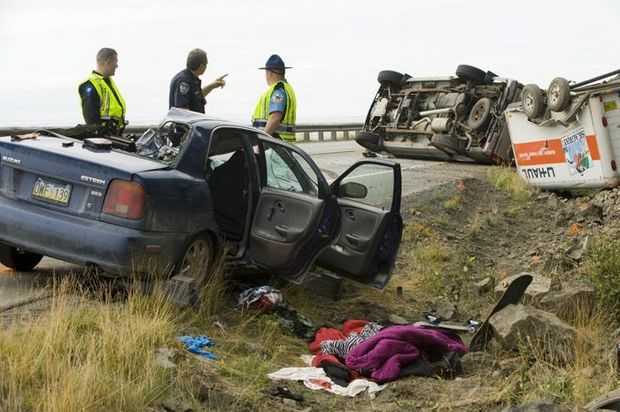
Troopers say that one southbound pickup truck trying to pass a line of vehicles collided with oncoming traffic. Two people were killed in the crash that involved four vehicles on Thursday, August 6, 2009.
Traffic is backed up on the Seward Highway along Turnagain Arm after a double fatality accident closed the road at milepost 111.5 on Thursday August 6, 2009.
Traffic is backed up on the Seward Highway along Turnagain Arm after a double fatality accident closed the road at milepost 111.5 on Thursday August 6, 2009.

Troopers say that one southbound pickup truck trying to pass a line of vehicles collided with oncoming traffic on the Seward Highway near mile 111.5. Two people were killed in the crash that involved four vehicles on Thursday, August 6, 2009.
Traffic is backed up on the Seward Highway along Turnagain Arm after a double fatality accident closed the road at milepost 111.5 on Thursday August 6, 2009.
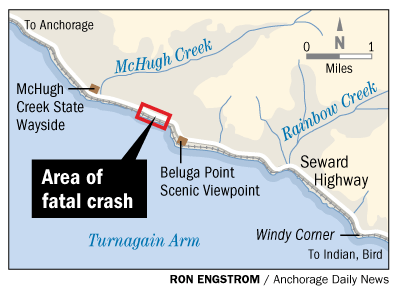
CLICK HERE FOR CRASH STATS - 2.3 MB FILE